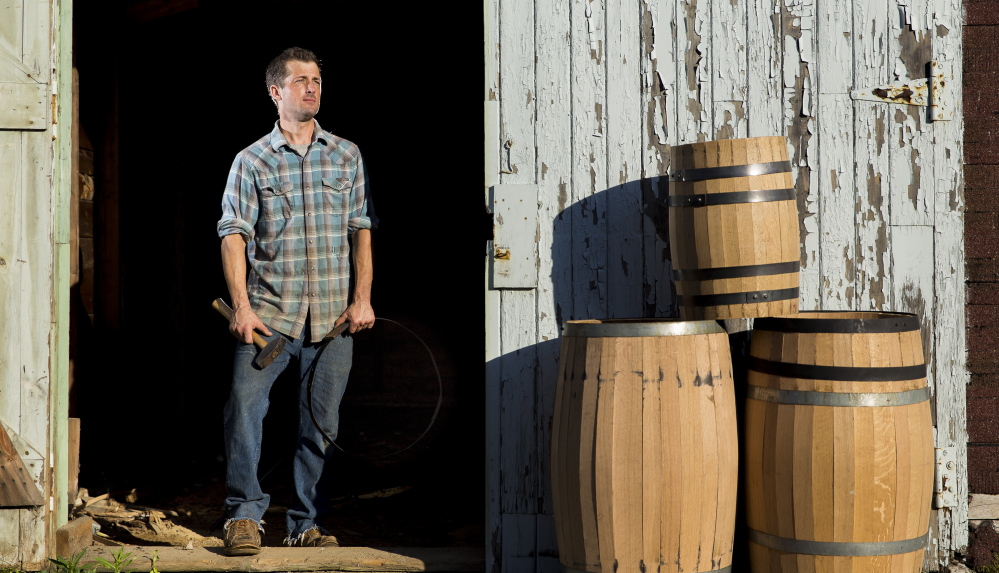Ed Lutjens is a cooper. Yeah, we didn’t know what that was either, although at one time, Maine was full of them. This is the technical name for the people who make wooden barrels wrapped in metal bands, the kind fine whiskey is aged in. The kind that fall off the back of stagecoaches in old Westerns. Read on to learn how Lutjens teamed up with Maine Craft Distilling, took a trip to The Bourbon Trail and carved – sorry, irresistible – himself a niche market in one of the sustainable world’s more indulgent products.
TEEN TRADE: Lutjens, who grew up in Winter Harbor and now lives in South Portland, started out as a blacksmith, a skill he was introduced to at 15 while participating in a high school outreach program at Haystack Mountain School of Crafts. He apprenticed with a blacksmith the next summer and has been making his living predominantly from blacksmithing and construction since then. He also passes on his skills, teaching at Maine Teen Camp in Porter, which has a forge of its own.
WHISKEY A-GO-GO: A little more than two years ago, Lutjens started talking to Luke Davidson, the chief distiller at Maine Craft Distilling about making barrels. Davidson wanted to age his spirits (rum and whiskey, primarily) in something locally made and uniquely Maine. Could Lutjens whip something up, preferably in a native white oak? Lutjens was intrigued. He knew metal and he knew wood, but he didn’t know barrels and there wasn’t much to go on. Anymore, anyway. There had been a cooperage in Portland that made 300,000 barrels a year in the mid-19th century, primarily for shipping to the West Indies. The lime industry in Rockland relied on local cooperages as well. “That is one of the frustrating things,” Lutjens said. “Up until recently there were coopers everywhere.” Between the Industrial Revolution and Prohibition, wooden barrel making took a big hit.
TEACH THYSELF: He had no luck finding someone to apprentice with. “There are something like only nine master coopers left in this country,” he said. So he headed South, to Jack Daniels country. “I went to The Bourbon Trail, from Louisville to Knoxville, in the Smoky Mountain area.” He managed to get onto the floor of a big manufacturing plant, which was helpful but not the place to learn how to hand-craft. “They have 300 guys on the floor three shifts a day. They are cranking.” As in, selling barrels by the tractor-trailer load. Lutjens hit the history books and started looking for old tools that would have been used at cooperages, including croze planes, which turned out to be highly individual. “I have never seen two croze planes that were the same. Every single one that I have been able to lay my hands on is different. That is because every one of them was made by hand to solve a problem.” To solve his problem, he started making his own. This is when it is very handy to be a blacksmith.
THE HARDEST PART? “I started making things that looked like barrels, but getting them to hold water was a whole other trick.” Lutjens has done some boat building, so he had some experience in this matter. Still, creating a seal “is like alchemy to me.” He tried many sizes, although 36-gallon barrels is what Davidson wants and needs. “It has taken me two years to get to a place where I can roll off of production something uniform and watertight.” Davidson is already putting them to use. Lutjens is also hoping to make barrels for Maine vintners. But he’s not quite ready to claim the official title. “I tell people I am a barrel maker, not a cooper. Not yet. I am an aspiring cooper.”
TREE TO BARREL: Another issue? Lumber. Maine Craft Distilling is all about farm to flask, so the Portland company had priorities for the barrels. “The distillers challenged me to make this out of Maine white oak.” Which is rot resistant and “tastes good” but is not available at, say, Hammond’s. Not air-dried anyway, which is a necessity. Moreover, it “doesn’t grow north of Augusta, really.” Lutjens picked up some in Kennebunk, and there’s a good bit growing in Phippsburg. He also has to give the barrel just the right level of charring, which caramelizes the sugar in the wood, which in turn flavors the spirits. To bring it all full circle, Lutjens gives his sawdust to Maine Cap N’ Stem for a growing medium at their mushroom farm in Westbrook.
FLAVOR AGENTS: About that tasting good aspect … can you clarify? “He (Davidson) is looking for something specific. Every distiller wants their liquor to be distinguishable from others, and the barrel plays a big part in this.” Not that Lutjens considers himself a total expert. “These are subtleties,” he said. “I don’t have a good enough palate to distinguish whether some of it is myth or not.” The final word on some of these flavors won’t come until the liquors have aged for 10 years. In the meantime, there are tastings to see how it’s shaping up, and the cooper lends a hand. “We’re tasting every month, every quarter. It’s a grand experiment.” Grand indeed, and if anyone needs help …
Send questions/comments to the editors.




Comments are no longer available on this story